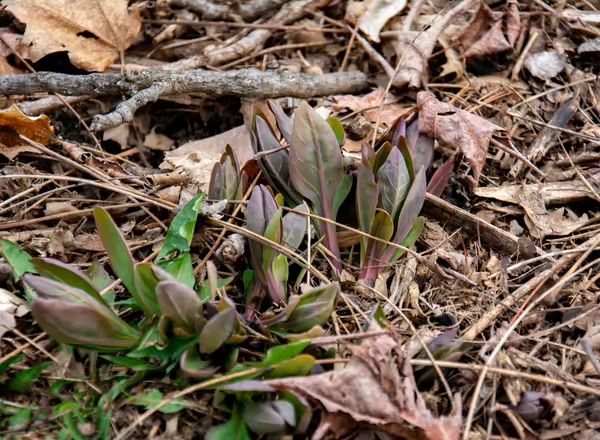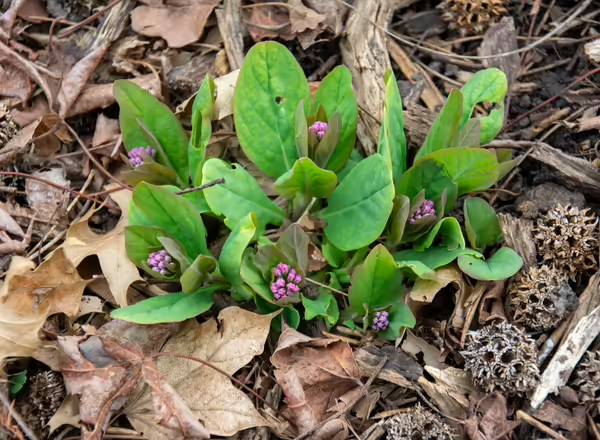
With the arrival of warmer weather in the spring, we start to see signs of new life in our landscapes. Birds begin singing, our landscapes start turning green again, and spring ephemeral plants start to emerge. Among the spring ephemerals in Illinois, one of the most captivating and commonly encountered are Virginia bluebells (Mertensia virginica).
Growing Virginia bluebells
In the wild, Virginia bluebells are found in moist woodland areas, often in floodplains or along streams, where they can form large patches. They are also increasingly grown in home landscapes, where they prefer partial shade and moist, fertile soils.
Plants will begin emerging in early spring once the soil begins to warm. When foliage first pokes through the ground, it will be purple but will quickly fade to green as the leaves expand and mature. The leaves will grow to be up to 7 inches long and are soft and appear somewhat 'floppy'. Plants will grow in clumps, reaching up to 2.5 feet tall and around a foot wide. The stems are partially hollow and break easily, so be careful when handling them.
While the foliage of the plants is attractive, it's the flowers that steal the show. In Illinois, bluebells flower from late March to late May. They will produce clusters of bell-shaped at the end of arching stems. The flowers begin as pink buds and will turn pinkish-purple and, finally, sky-blue after they open. You may occasionally come across plants that produce all pink or even white flowers. Plants will bloom for about three weeks. Despite their beauty, bluebells, unfortunately, aren't good candidates for cut flowers.



Bluebells and pollinators
Because bluebells bloom early in the season, they are an important food source for many pollinators, particularly bees. Due to their long tubular flowers, it can be difficult for some pollinators to access the nectar. However, some bees with longer tongues, like some bumblebees, honeybees, and mason bees, can easily access the nectar and can often be found visiting bluebells. Bumblebee queens frequently visit bluebells to search for and establish new nests in the spring.
Bees with shorter tongues will frequently 'rob' nectar from flowers by cutting a hole at the base of the flower so they can access nectar. These bees will bypass the flower's reproductive parts and, therefore, not pollinate them.
This sounds like it would be detrimental to the plant (less pollination), but researchers have found that Virginia bluebell flowers that had their nectar robbed produced more seed than those that weren't robbed. One explanation is that bees that aren't robbing nectar will have to visit more flowers to find nectar and, therefore, transfer more pollen.
In addition to bees, flowers of Virginia bluebells will be visited by flies, butterflies, skippers, moths, and, if they arrive in time, hummingbirds.
Here today, gone tomorrow
Spring ephemeral wildflowers, like Virginia bluebells, are typically found in wooded locations. In the early spring, before trees leaf out, much of the sunlight will be able to reach the forest floor. However, once trees and shrubs begin leafing out, less and less light will be available.
Because of this, spring ephemerals have a narrow window in which to bloom and produce seeds before they are shaded out by trees. By the time the tree canopy fills, they will flower and produce seed before withering, fading, and going dormant until the following spring.
Gardening with ephemerals
Because of their fleeting nature, ephemerals like Virgina bluebells, trillium, or bloodroot will leave "holes" in the landscape during the summer and fall. If you are going to be incorporating spring ephemerals, take some time to think about what will fill the holes these plants will leave behind.
Spring ephemerals can be interplanted with other shade-loving plants such as hostas, astilbe, Solomon's seal, and ferns. As your spring ephemerals start declining, these other plants will take off and fill in the bare patches the ephemerals leave behind. Shade-loving annuals like coleus, impatiens, and begonias could also be planted; make sure to plant them before your ephemerals fade or mark where they are so you don't damage or disturb them while planting.
Good Growing Fact of the Week: The flowers of Virginia bluebells change colors due to the changing pH in their cell sap. As the pH drops, the flowers will become blue. Plants grown in more acidic soils may have deeper blue flowers.
Resources and for more information
Enz, John J. 1998. "Reproductive Biology and Pollination Ecology of Mertensia virginica (L.) Pers." Order No. 9907052, University of Louisville. https://www.proquest.com/dissertations-theses/reproductive-biology-pollination-ecology/docview/304428734/se-2.
Gracie, Carol. "Virginia Bluebells." In Spring Wildflowers of the Northeast: A Natural History, 223–27. Princeton University Press, 2012. http://www.jstor.org/stable/j.ctt7rk4h.34.
Robertson, Charles. 1928. Flowers and Insects: Lists of Visitors of Four Hundred and Fifty-three Flowers. The Science Press Printing Company. https://archive.org/details/flowersinsectsli00robe.
Want to get notified when new Good Growing posts are available? SIGN ME UP!
Give us feedback! How helpful was this information (click one): Very helpful | Somewhat helpful | Not very helpful
MEET THE AUTHOR
Ken Johnson is a Horticulture Educator with University of Illinois Extension, serving Calhoun, Cass, Greene, Morgan, and Scott counties since 2013. Ken provides horticulture programming with an emphasis on fruit and vegetable production, pest management, and beneficial insects. Through his programming, he aims to increase backyard food production and foster a greater appreciation of insects.